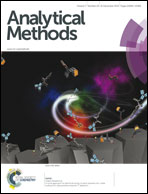Electrochemical immunoassay based on polythionine as the signal source for the sensitive detection of carcinoma embryonic antigen†
Abstract
In this work, an effective immunosensor based on polythionine (PTh) as the signal source was fabricated for the facile and sensitive detection of carcinoma embryonic antigen (CEA) in human serum. With the help of Nafion, anti-CEA antibodies were immobilized on the surface of the PTh modified electrode. The morphology and electrochemical behaviors of the fabrication process of the immunosensor were characterized by electrochemical impedance spectroscopy (EIS), differential pulse voltammetry (DPV) and atomic force microscopy (AFM). The rangeability of the anodic peak current before and after the CEA immobilization was directly related to the concentration of CEA. A linear equation of the CEA concentrations ranging from 1 × 10−12 to 1 × 10−6 g mL−1 with a detection limit of 0.1 pg mL−1 was obtained. The proposed method had high sensitivity, good selectivity and acceptable reproducibility for the detection of CEA. The analytical results of the serum specimen show that the use of the proposed immunosensor is a promising alternative approach for the detection of biomarkers in clinical diagnosis.


 Please wait while we load your content...
Please wait while we load your content...